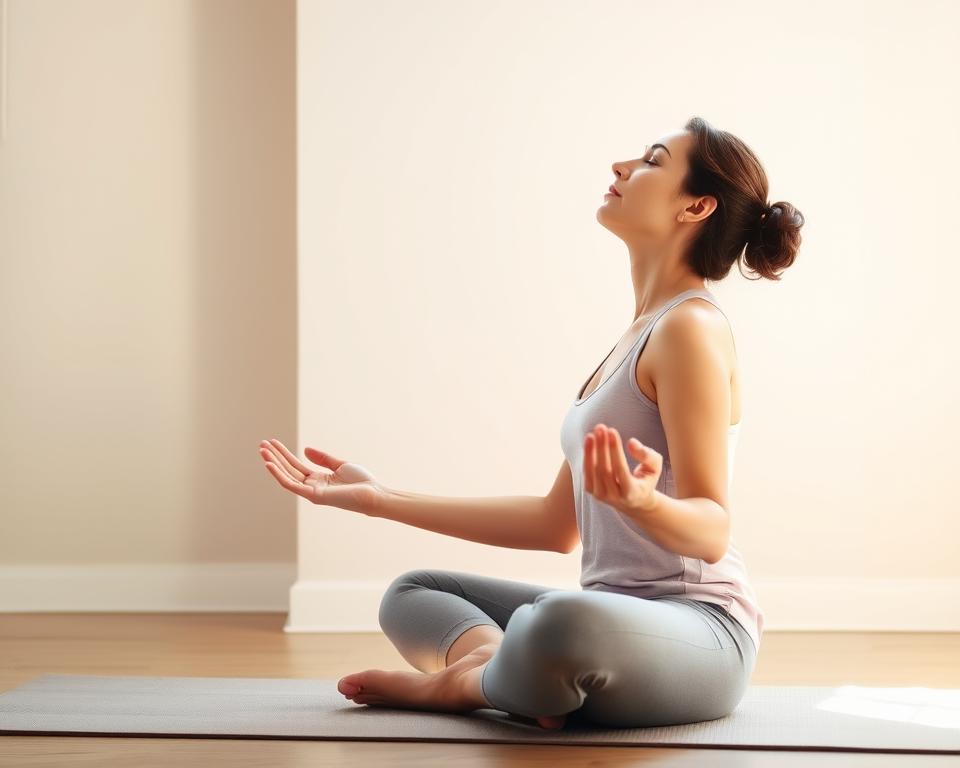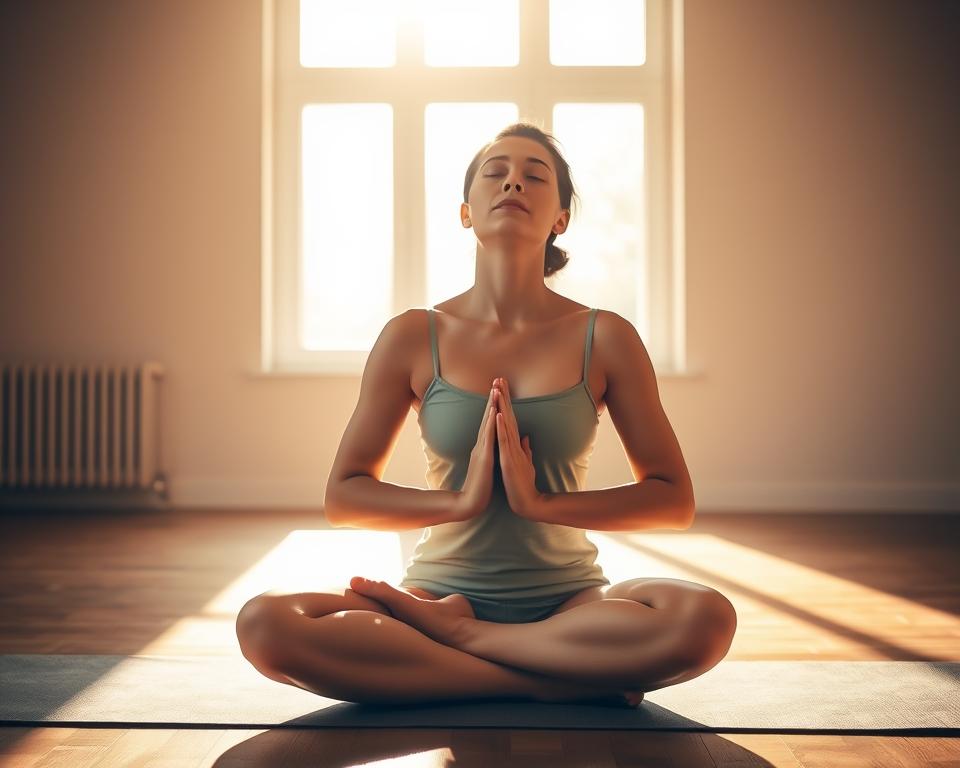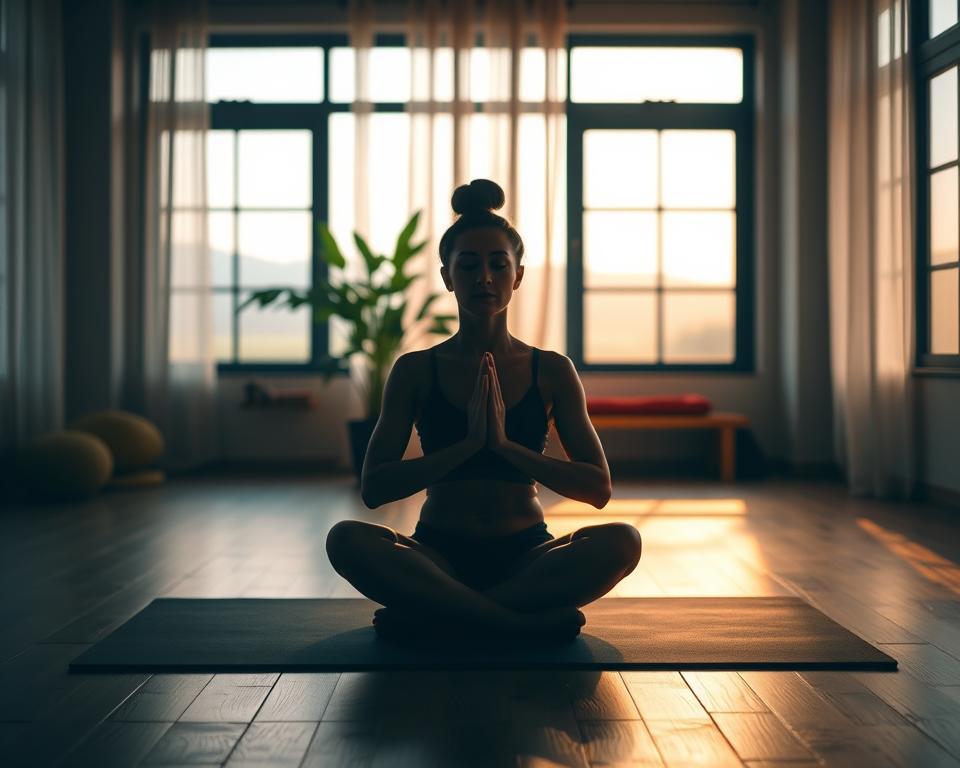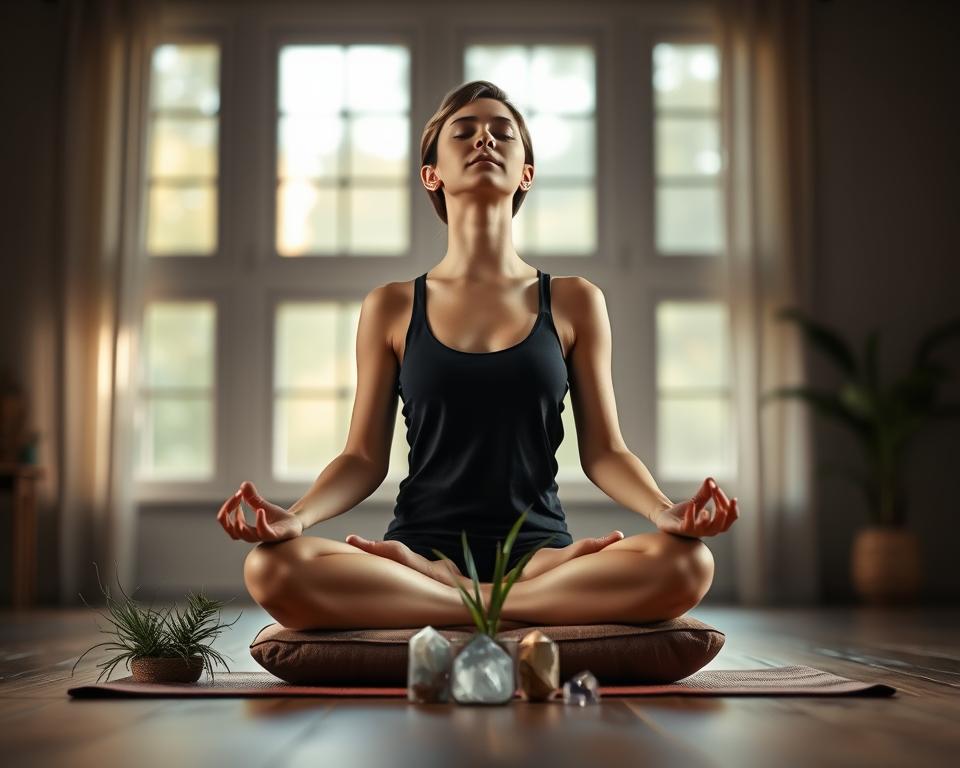Did you know you take over 20,000 breaths every day? Breathing is essential, yet we often overlook it. The ancient yogic practice of pranayama, or breath control, can turn breathing into a powerful tool. It improves both physical and mental health.

Pranayama uses yogic breathing techniques to control the breath. By practicing pranayama regularly, you can enjoy many health benefits. These include less stress and anxiety, better lung function, and improved thinking skills. It’s a simple yet effective way to boost your life quality.
Key Takeaways
- Pranayama is an ancient yogic breathing practice that can improve physical and mental health
- Breath control techniques can reduce stress, anxiety, and hypertension
- Pranayama can strengthen respiratory muscles and increase lung capacity
- Regular practice of pranayama can enhance mindfulness, attention, and cognitive function
- Yogic breathing exercises may aid in smoking cessation and managing psychosomatic disorders
What is Pranayama?
Pranayama is an ancient yogic practice that focuses on controlling the breath. It comes from Sanskrit words: prana, meaning life energy or breath, and ayama, meaning expansion or control. By using pranayama, you can improve your physical, mental, and spiritual health.
Pranayama is more than simple breathing. It’s about connecting your body and mind through breath control. This practice helps you find inner peace, clarity, and energy.
The Meaning of Pranayama
The word pranayama is deeply meaningful in yoga. Prana is the universal life force energy in all living beings. It keeps the body, mind, and spirit alive. Ayama means to extend or control. So, pranayama is about controlling the breath to flow prana better.
Practicing pranayama lets you tap into life force energy. It helps in healing, balance, and change. As you breathe deeply, you release tension, clear blockages, and find calm and energy.
The Three Phases of Pranayama
A typical pranayama cycle has three main phases:
- Puraka (Inhalation): This phase is a slow, deep breath in through the nostrils. You take in fresh oxygen and prana, filling your lungs and expanding your abdomen.
- Kumbhaka (Retention): After breathing in, you hold your breath for a short time. This lets prana circulate, oxygenating cells and bringing inner calm.
- Rechaka (Exhalation): The last phase is a slow, controlled breath out through the nostrils. You release carbon dioxide and any tension, leading to relaxation.
By focusing on these three phases, you become more aware of your breath. This awareness can greatly improve your physical, mental, and emotional health. Regular practice makes pranayama a powerful tool for self-discovery and personal growth.
Types of Pranayama Techniques
Pranayama is an ancient practice of breath control. It offers various breathing exercises for physical, mental, and emotional health. Each technique has unique benefits, like energy clearing and calming the nervous system. Let’s look at some popular pranayama techniques and how they can improve your health.
Bhastrika Pranayama (Bellows Breath)
Bhastrika pranayama, or bellows breath, is a dynamic exercise. It involves deep, forceful breaths. This technique boosts energy, improves digestion, and increases lung capacity.
To practice, sit with your spine straight. Take deep, rapid breaths through your nose. Focus on the movement of your abdomen.
Kapal Bhati Pranayama (Skull Shining Breath)
Kapal bhati pranayama, or skull shining breath, is a cleansing technique. It involves forceful exhalations followed by passive inhalations. This practice detoxifies the body, improves digestion, and boosts mental clarity.
To perform, sit with your spine straight. Take short, powerful breaths. Contract your abdominal muscles during exhalation.
Nadi Shodhana Pranayama (Alternate Nostril Breathing)
Nadi shodhana pranayama, or alternate nostril breathing, balances the brain. It involves breathing through one nostril at a time. This technique promotes mental clarity and emotional stability.
To practice, sit comfortably. Use your right thumb and ring finger to close each nostril as you inhale and exhale.
Bhramari Pranayama (Humming Bee Breath)
Bhramari pranayama, or humming bee breath, is calming. It involves making a humming sound during exhalation. This practice reduces stress, anxiety, and tension, promoting inner peace.
To perform, sit with your eyes closed. Place your index fingers on your ears. Inhale deeply, then exhale slowly while humming.
Adding these pranayama techniques to your daily routine can enhance self-awareness and well-being. Start slowly and listen to your body. Gradually increase the duration and intensity of your sessions.
Pranayama and Stress Relief
In today’s world, stress is common. But, pranayama offers a way to reduce stress and regulate emotions. It focuses on controlling your breath, leading to deep relaxation and calm.
Studies show pranayama lowers anxiety and aggression. It triggers your body’s relaxation response. This soothes your nervous system and brings tranquility.
A study in the Journal of Alternative and Complementary Medicine found pranayama’s benefits. Participants who practiced for 15 minutes a day felt less stressed than a control group. This shows pranayama’s impact on well-being.
Pranayama helps with stress relief in several ways:
- Slowing down your breath calms your mind and body
- More oxygen to the brain improves focus and clarity
- It activates the parasympathetic nervous system for relaxation
- It helps regulate emotions, bringing balance and harmony
Adding pranayama to your daily routine can manage stress and enhance life quality. Here are some stress-relief pranayama practices:
| Pranayama Practice | Duration | Frequency |
|---|---|---|
| Nadi Shodhana (Alternate Nostril Breathing) | 5-10 minutes | 1-2 times daily |
| Bhramari (Humming Bee Breath) | 3-5 minutes | 1-2 times daily |
| Ujjayi (Victorious Breath) | 5-10 minutes | 1-2 times daily |
Just a few minutes each day can bring deep relaxation and balance. Exploring pranayama can help you face life’s challenges more easily.
“Breath is the bridge which connects life to consciousness, which unites your body to your thoughts.” – Thich Nhat Hanh
Bhattacharya, S., Pandey, U. S., & Verma, N. S. (2002). Improvement in oxidative status with yogic breathing in young healthy males. Indian Journal of Physiology and Pharmacology, 46(3), 349-354.
Pranayama for Improved Lung Function
Pranayama, an ancient yogic practice, helps a lot with breathing and lung health. It makes your breathing better and strengthens your lungs. Adding pranayama to your daily routine can boost your lung capacity and breathing efficiency.

Pranayama can help people with asthma and COPD feel better. It makes you breathe deeply and mindfully. This helps your lungs expand and take in more oxygen.
Strengthening Respiratory Muscles
Pranayama works on the diaphragm, intercostal muscles, and abdominal muscles. These muscles are key for breathing. By strengthening them, you breathe better and your lungs work more efficiently.
Increasing Lung Capacity
Techniques like Bhastrika and Kapal Bhati involve quick exhales and passive inhales. They clear out old air and bring in fresh oxygen. Regular practice can make your lungs bigger, so you can breathe in more oxygen.
Adding pranayama to your daily life can greatly improve your breathing. It’s great for boosting lung function, managing breathing issues, or just feeling better overall. The power of breath control through pranayama is truly amazing.
Pranayama and Mindfulness
Pranayama is closely linked with mindfulness. It focuses on the breath, bringing you to the present moment. This practice can lead to inner peace and clarity.
Pranayama asks you to watch your breath closely. This quietens the mind, making you more present. Regular practice improves mindfulness in daily life, even when things get tough.
Enhancing Awareness and Attention
Pranayama boosts awareness and attention. It trains you to notice your breath and yourself better. This awareness spreads to thoughts, emotions, and body sensations.
It also sharpens your focus. By controlling your breath, you learn to stay focused. This skill helps in all areas of life, making tasks clearer and more focused.
Cultivating Present Moment Focus
In today’s fast world, it’s easy to get lost in thoughts. Pranayama brings you back to the now. It anchors your mind in the breath, helping you stay present.
The table below shows how pranayama helps focus on the present:
| Pranayama Technique | Benefits for Present Moment Focus |
|---|---|
| Slow, deep breathing | Calms the mind and reduces stress, allowing for greater presence |
| Alternate nostril breathing | Balances the left and right hemispheres of the brain, promoting mental clarity and focus |
| Breath retention | Increases awareness of the body and breath, anchoring attention in the present moment |
Adding pranayama to your day boosts mindfulness and presence. As you get better, you’ll live life more fully, enjoying each moment.
Pranayama for Anxiety Management
Looking for a natural way to lower anxiety? Pranayama might be what you need. This ancient breathing method has been proven to reduce anxiety and negative feelings. Just one session can help, and regular practice can help manage anxiety better over time.
Pranayama boosts your awareness and relaxation. By focusing on your breath, you become more present and calm. This mindful breathing activates your parasympathetic nervous system, bringing calm and ease.

Studies show pranayama can also change stress molecules in your body. It regulates your nervous system and triggers a relaxation response. This lowers cortisol and stress hormones that cause anxiety.
Some pranayama techniques are great for anxiety:
- Nadi Shodhana (Alternate Nostril Breathing): Balances the nervous system and calms the mind.
- Bhramari Pranayama (Humming Bee Breath): Stimulates the vagus nerve, reducing anxiety and promoting relaxation.
- Ujjayi Pranayama (Victorious Breath): Soothes the nervous system and decreases heart rate, helping to alleviate anxiety.
Adding these pranayama techniques to your daily routine can help manage anxiety naturally. Whether it’s occasional stress or chronic anxiety, pranayama is a simple yet effective tool for nervous system regulation and better emotional well-being.
Pranayama and Hypertension
Pranayama, an ancient breath control practice, improves cardiovascular health and helps with high blood pressure. It promotes relaxation and stress reduction. This helps regulate the nervous system and lowers blood pressure.
A study in the International Journal of Yoga looked at pranayama’s effects on mild hypertension. It included 50 participants, split into two groups:
- Group A took antihypertensive drugs for 6 weeks
- Group B took drugs and did pranayama for 6 weeks
The study found both groups had lower heart rates. But Group B saw more blood pressure drop:
| Group | Blood Pressure (mmHg) | Rate Pressure Product |
|---|---|---|
| Group A | Decreased | 114.66 ± 26.30 |
| Group B | 148 ± 8.09 to 127 ± 12.10 | 96.73 ± 20.53 |

Lowering Systolic Blood Pressure
Techniques like bee breath and slow breathing in pranayama lower systolic blood pressure. Deep, controlled breathing calms the mind and body. This reduces stress and blood pressure.
Regulating the Nervous System
Pranayama balances the autonomic nervous system, key for blood pressure control. It promotes relaxation and reduces stress. This balances the nervous system, lowering hypertension risks like heart disease and stroke.
Adding pranayama to your daily routine, with a healthy diet and exercise, can manage high blood pressure and boost cardiovascular health.
Pranayama for Cognitive Function
Pranayama, or controlled breathing, boosts cognitive performance and brain function. It increases oxygen to the brain and lowers stress. This sharpens focus, improves memory, and enhances mental clarity. Research shows that regular practice enhances neuroplasticity. This lets the brain adapt and learn better.

Slow and fast pranayama techniques both benefit the mind. Slow methods, like Nadi Shodhana, balance the brain and reduce anxiety. Fast techniques, like Kapalabhati, energize the mind and improve blood flow to the brain.
Improving Auditory and Sensory-Motor Skills
Pranayama also boosts auditory processing and sensory-motor skills. Studies show it improves sound processing and attention. This lets people better understand sounds around them.
Pranayama also enhances sensory-motor integration. This means better coordination between senses and physical actions. It leads to quicker reactions, better balance, and improved physical performance.
To get the most from pranayama, practice daily for 10-15 minutes. Mix different techniques like Nadi Shodhana, Kapalabhati, and Bhramari. This targets various brain functions and boosts mental health.
Pranayama as a Smoking Cessation Aid
Struggling to quit smoking? You might find help in an unexpected place: your breath. Pranayama, the yogic practice of breath control, is a promising tool for smoking cessation. It helps manage nicotine cravings and withdrawal symptoms, making quitting easier.
Studies show that some pranayama techniques are great for quitting smoking. For instance, Kapal Bhati pranayama, or “Skull Shining Breath,” involves quick exhalations followed by deep inhalations. It boosts blood flow, energizes the nervous system, and calms the mind, helping you fight the urge to smoke.
Nadi Shodhana pranayama, or “Alternate Nostril Breathing,” is another helpful practice. It involves breathing through one nostril at a time. This technique releases stress, balances energy, and helps with respiratory problems from smoking. Adding these pranayama techniques to your daily routine can help manage addiction.
| Pranayama Technique | Benefits for Smoking Cessation |
|---|---|
| Kapal Bhati (Skull Shining Breath) | Improves circulation, energizes nervous system, calms mind to resist urges |
| Nadi Shodhana (Alternate Nostril Breathing) | Releases stress, purifies energy channels, helps respiratory issues from smoking |
Pranayama’s breathing techniques can be a strong ally in quitting smoking. They reduce stress, improve lung function, and increase mindfulness. This helps you manage cravings and withdrawal symptoms. Use the power of your breath to move closer to a healthier, smoke-free life.
Pranayama and Psychosomatic Disorders
The mind-body connection is key in psychosomatic conditions. These are when mental and emotional issues show up as physical symptoms. Pranayama, or breath control, is a powerful tool to manage these issues. It helps you relax deeply and be more mindful.
Conditions like migraines, ulcers, and psoriasis can really affect you. They impact both your body and mind. Adding pranayama to your day can help. It lets you use your breath to heal and find balance.

- Lower stress and anxiety
- Bring deep relaxation
- Boost mindfulness and self-awareness
- Improve emotional health
Pranayama helps you tackle the mental issues behind psychosomatic conditions. It lets you take charge of your health. As you practice more, you might see your symptoms get better.
| Condition | Potential Benefits |
|---|---|
| Migraines | Less frequent and severe headaches |
| Ulcers | Better digestion and less stomach pain |
| Psoriasis | Less inflammation and better skin |
Remember, pranayama is a strong ally against psychosomatic disorders. It helps you find health and well-being. By practicing regularly and honoring the mind-body connection, you can change your life. You’ll feel more at peace, resilient, and full of life.
Conclusion
Pranayama, the ancient practice of breath control, offers many pranayama benefits for your health. It helps with physical, mental, and emotional well-being. By adding pranayama to your daily routine, you can feel more connected and healthy.
Pranayama can help reduce stress and improve lung function. It also boosts your brain power. These benefits show how wide-reaching pranayama’s effects are.
Pranayama is easy to add to your wellness routine. It can help with high blood pressure, breathing problems, or finding peace. With practice and a good teacher, you can see pranayama’s amazing effects.
Using pranayama can make your life more balanced and fulfilling. It connects your mind and body, leading to better well-being. So, take a deep breath and explore pranayama. See how it can help you thrive today.
